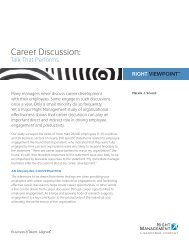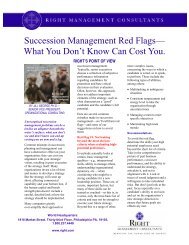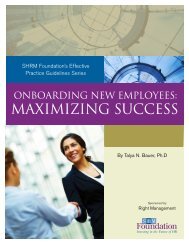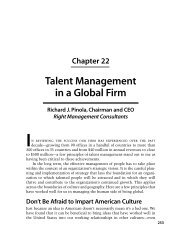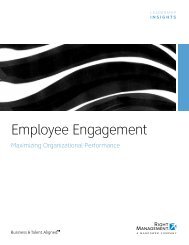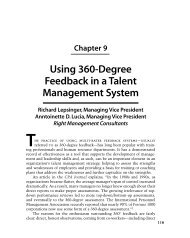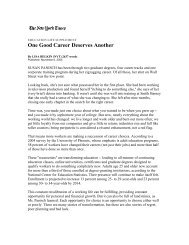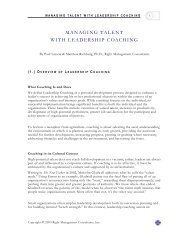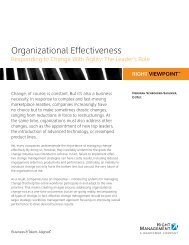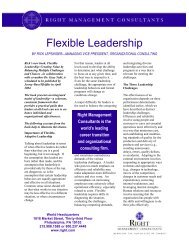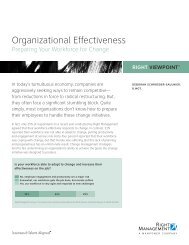Organizational Effectiveness - Right Management
Organizational Effectiveness - Right Management
Organizational Effectiveness - Right Management
You also want an ePaper? Increase the reach of your titles
YUMPU automatically turns print PDFs into web optimized ePapers that Google loves.
<strong>Organizational</strong> <strong>Effectiveness</strong><br />
Five Steps to Navigating Workforce Strategy<br />
Success in today’s hyper-competitive global economy<br />
requires a clear vision of where a company wants to go,<br />
the strategy to take it there and the value it delivers. To<br />
achieve that success, a company must apply the same<br />
rigor in developing a workforce strategy as it does in<br />
creating a business strategy.<br />
In the changing world of work, the one constant is the need for an<br />
exceptional workforce. This is regardless of the economic environment,<br />
your industry or geography, your size or your earnings. This strategy<br />
requires a comprehensive understanding of how complex trends and<br />
shifting business realities will impact your business–now and in the future.<br />
Increasingly, the demands and composition of the workforce are shifting<br />
in response to economic, social, political and demographic trends. The<br />
need for more specific skills is creating a growing talent mismatch and<br />
scarcity of ready-now leaders. Multiple generations and cultures in the<br />
workplace have resulted in changes in motivations and preferences–<br />
profoundly impacting individual choice. Technological developments<br />
allow new ways of getting work done. It has never been more challenging<br />
to manage your workforce effectively.<br />
Despite their varied implications, these trends revolve around one central<br />
theme –the need to empower the right people, in the right places, in the<br />
right ways. This requires a sustained commitment to, and a strategic<br />
investment in, talent. The company that pays the most attention will win.<br />
RIGHT VIEWPOINT <br />
Dr. Deborah Schroeder-Saulnier<br />
“ In the changing world<br />
of work, the one constant<br />
is the need for an<br />
exceptional workforce.”
Your talent assets need to be managed as aggressively as the fine-tuning<br />
you apply to other organizational assets. Everything else fails if you don’t<br />
have the right talent in place.<br />
This requires an alignment of workforce strategy with business goals. Talent is<br />
the number-one impediment or success factor to executing your business plan.<br />
To navigate an effective workforce strategy, senior leadership must first identify<br />
and gain alignment around top workforce priorities. In this context, leadership<br />
needs to home in on the needs and supporting practices for critical dimensions<br />
required for the workforce to perform at optimum levels. Such dimensions<br />
include:<br />
• Strategy–The overall purpose, strategic intent and expected business<br />
outcomes of an organization.<br />
• Flexibility–The ability of the organization to manage its fixed and variable<br />
costs for the highest possible return on human and financial resources.<br />
• Culture–The daily expression of an organization’s values, behaviors,<br />
mindset and tone.<br />
• Leadership–The values, behaviors, mindset and tone set by those<br />
responsible for driving the culture, performance and execution of the<br />
business strategy.<br />
• Engagement–The values, behaviors and activities that motivate the<br />
workforce to exert greater discretionary effort in the performance of<br />
their responsibilities.<br />
• Capability–The skills, abilities, characteristics and resources to deliver<br />
on the business strategy.<br />
Why make the investment? Building an exceptional workforce will drive higher<br />
levels of performance and will positively impact your organization’s ability to<br />
deliver on its business strategy. Investing in this process up front will identify<br />
constraints and accelerators to organizational performance–top strengths to<br />
leverage and top priorities to fund and why. Furthermore, it will increase executive<br />
alignment across functions and geographies, while also aligning talent<br />
initiatives to business goals–whether they are related to globalization, growth,<br />
productivity or even the brand.<br />
2<br />
“ Building an exceptional<br />
workforce will drive<br />
higher levels of performance<br />
and will positively<br />
impact your organization’s<br />
ability to deliver on its<br />
business strategy.”
ArChitECting WorkForCE StrAtEgy<br />
It all starts with assessing the strengths and gaps of existing talent and business<br />
capability, balanced against what is needed to fulfill the business objectives<br />
today and in the future. To achieve this, we recommend a five-step process:<br />
1. Engage Senior Leaders<br />
The first step in the process involves a conversation with senior leaders to<br />
better understand the business context and the need for alignment around<br />
the top workforce priorities. During this discussion it is important to understand<br />
the organization’s goals and identify all stakeholders who should be<br />
asked to weigh in on the next step.<br />
2. Interview All Stakeholders<br />
We recommend conducting brief one-on-one interviews with all stakeholders<br />
to introduce the objectives of the process, and to gain their perspectives on<br />
the greatest challenges and needs facing the organization. These interviews<br />
are an important part of the discovery process, and establish understanding<br />
and commitment.<br />
3. Gather the Data and Assess Priorities<br />
Conduct an assessment that asks leaders to consider key workforce<br />
challenges and the strategic choices being faced–the what and the how<br />
of your workforce strategy.<br />
3<br />
• The What: Leaders individually rank workforce strategy “needs” along two<br />
dimensions–Importance to the organization and Satisfaction with the<br />
organization’s ability to execute.<br />
• The How: Leaders then assess how effective the organization is at delivering<br />
best-in-class work practices by ranking workforce strategy “practices”<br />
along two dimensions–Value they believe them to have for the organization<br />
and <strong>Effectiveness</strong> in executing the practices today.<br />
4. Analyze Results<br />
After the assessment is completed, analyze and share initial findings with<br />
the Leadership Team, highlighting areas of greatest alignment and variance<br />
across six key dimensions: Strategy, Flexibility, Culture, Leadership, Engagement<br />
and Capability.<br />
5. Develop and Implement an Action Plan<br />
Conduct an action-planning session that helps leaders align around the<br />
strategic choices that are required to execute on business strategy. The key<br />
outcome is a tailored implementation plan that will drive accountability for<br />
execution and results in the organization.
How does a workforce strategy play out in reality?<br />
Here are a few examples:<br />
4<br />
BuSinESS CAtEgory idEntiFiEd nEEd PrACtiCE For imPLEmEntAtion<br />
Strategy Innovation Identifying and implementing new ideas, activities and work processes<br />
that develop and expand the organization’s capability to execute its<br />
business strategy.<br />
Flexibility Cross-Border Mobility Leveraging talent from other countries to augment the existing<br />
workforce, and assimilating them to the culture and environment so<br />
they are immediately productive.<br />
Culture Cultural Assessment Defining the culture required to deliver your desired customer experience,<br />
and developing a plan to institutionalize the desired culture in<br />
the organization.<br />
Leadership Leadership Coaching Developing and implementing formal and informal programs to<br />
provide leaders with supportive feedback and coaching, thereby<br />
enabling them to grow and be more effective in current and future<br />
roles. Coaching is provided through experienced external and/or<br />
internal coaches.<br />
Engagement High-Potential Talent<br />
Engagement<br />
Capability Business Performance<br />
<strong>Management</strong><br />
Engaging high-potential employees and individual contributors by<br />
understanding what motivates them. Developing and implementing<br />
personalized individual career-path plans that ensure their successes<br />
and drive commitment to the organization.<br />
Developing management methodologies, metrics and technology to<br />
drive alignment of business activities to the strategic objectives of an<br />
organization.
ConCLuSion<br />
You have many options for the creation of a workforce operating model,<br />
and a plan for talent acquisition, compensation, retention, performance<br />
management, development, redeployment and transition. The key is to align<br />
the right workforce strategy with your business strategy. To achieve this, it’s<br />
critical that leadership is aligned on the priorities and gaps and the practices<br />
to address them.<br />
Undoubtedly, your most valuable asset continues to be your workforce. How<br />
you manage this asset spells the difference between success and failure.<br />
Most people follow traditional approaches to workforce planning … identifying<br />
skills, the number of employees needed and where they will get them.<br />
Forward-looking, more strategic professionals address how broader trends and<br />
social, political and economic forces will affect their long-term business needs,<br />
and then they shape the workforce strategy to address these. It is only from<br />
here that a well-architected talent plan can be built to meet and align with<br />
business objectives.<br />
5<br />
CASE Study<br />
Aligning Workforce Strategy with Business Change<br />
Situation<br />
A U.S. real estate investment firm faced unprecedented regulatory changes that seriously<br />
altered the business operating environment. The newly appointed CEO wanted<br />
to create a strategy that could help the firm embrace the new external changes while<br />
also building leadership capacity and developing talent at all levels.<br />
Solution<br />
Utilizing the WorkforceNavigator tool, an interactive data-gathering process was<br />
implemented to help senior leaders identify their responsibilities for driving the<br />
required business change. WorkforceNavigator provided a forum to clarify priorities,<br />
their impact and the subsequent decisions required to align the workforce with the<br />
change in strategy. Through this discovery process, it became apparent that field managers<br />
were ill-equipped to handle the change and needed accelerated management<br />
development programs to improve key skills (such as building trust, communications<br />
and delegating).<br />
results<br />
WorkforceNavigator connected the senior leaders to the impact of the business on<br />
workforce strategy, created pillars for development for field managers, and guided<br />
the appropriation of funds towards implementing the organizational changes and the<br />
much-needed managerial development. In the words of the CEO: “We wouldn’t have<br />
gotten here this fast and as effectively without the WorkforceNavigator-facilitated<br />
process. It painted the talent management strategy for us.”<br />
About the Author<br />
Dr. Deborah Schroeder-Saulnier is Senior<br />
Vice President for <strong>Right</strong> <strong>Management</strong>’s<br />
Global Solutions Team with responsibility<br />
for overseeing the firm’s Leader Development,<br />
<strong>Organizational</strong> <strong>Effectiveness</strong>, and<br />
Employee Engagement solutions portfolio—focused<br />
on aligning talent management<br />
strategy with business strategy.<br />
About <strong>Right</strong> <strong>Management</strong><br />
<strong>Right</strong> <strong>Management</strong> (www.right.com) is the<br />
talent and career management expert<br />
within Manpower, the global leader in<br />
employment services. <strong>Right</strong> <strong>Management</strong><br />
helps clients win in the changing world of<br />
work by designing and executing workforce<br />
solutions that align talent strategy<br />
with business strategy. Our expertise<br />
spans Talent Assessment, Leader Development,<br />
<strong>Organizational</strong> <strong>Effectiveness</strong>,<br />
Employee Engagement, and Workforce<br />
Transition and Outplacement. With offices<br />
in over 50 countries, <strong>Right</strong> <strong>Management</strong><br />
partners with companies of all sizes. More<br />
than 80 percent of Fortune 500 companies<br />
are currently working with us to<br />
help them grow talent, reduce costs and<br />
accelerate performance.<br />
© <strong>Right</strong> <strong>Management</strong> 2010.<br />
All <strong>Right</strong>s Reserved.<br />
www.right.com 1.800.237.4448<br />
Follow us on twitter:<br />
twitter.com/rightupdates<br />
Like us on Facebook:<br />
facebook.com/rightmanagement<br />
Subscribe to Talent@Work<br />
right.com/blog



